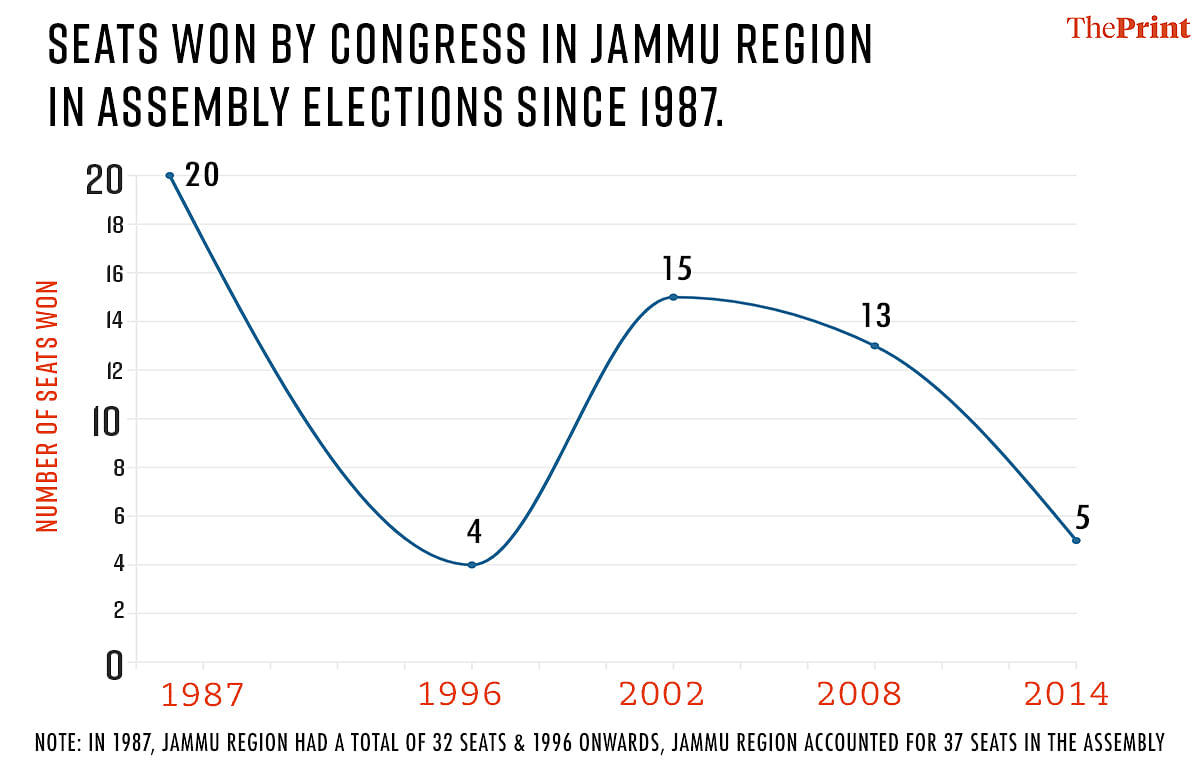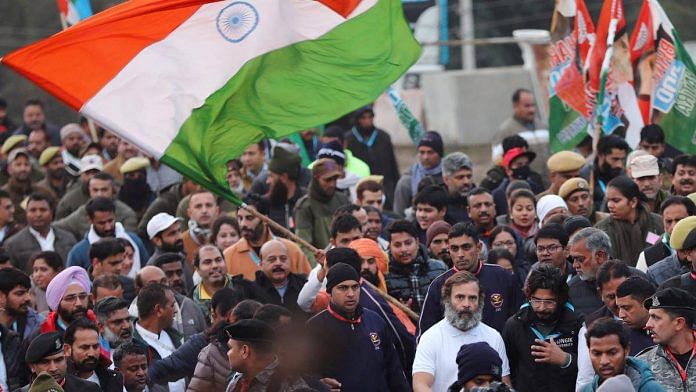Jammu/Nagrota/Udhampur: As his Bharat Jodo Yatra left Jammu and entered the Kashmir valley Friday, Rahul Gandhi left a trail of hope in the Jammu Congress.
Thousands thronged the streets when the yatra entered Jammu & Kashmir last week. Crowds on either side of Gandhi’s tight security ring as he walked across the Jammu region, buoyed the party cadre.
Going by numbers, the Congress has over the years become virtually irrelevant in the region.
The party’s seat tally — from a high of 20 of 32 seats in the Jammu region in the 1987 J&K assembly polls to 15 of 37 seats (post-1995 delimitation) in the 2002 J&K election, to a mere 5 of 37 seats in Jammu region in the 2014 polls, indicates its place on the political margins today.
The Jammu region has 10 districts and one of them is the Hindu-majority Jammu district. Five of the 10 districts — Kishtwar, Poonch, Rajouri, Doda and Ramban — are Muslim-majority.
In 2014, the Congress didn’t win a single seat in Jammu district. Two of the five assembly seats it won were from Reasi district and one each from Kishtwar, Ramban and Poonch districts.
During the previous two best performances of the Congress in Jammu region — in 1987 and 2002 — it had won the maximum seats in Jammu district.

The Congress’ marginalisation in the region was further made evident last week from the crop of leaders who walked with Gandhi as part of the Bharat Jodo Yatra.
In Jammu’s Kathua district, the party owed a healthy gathering to former Congressman Chaudhary Lal Singh, who had faced flak for allegedly supporting the Kathua rape accused in 2018.
A two-time Congress MP from Udhampur, Singh jumped ship to join the BJP shortly after the 2014 Lok Sabha election. In 2019, he formed his own Dogra Swabhiman Sangathan Party.
Seen by Rahul’s side during the yatra were Jammu & Kashmir Pradesh Congress Committee (JKPCC) chief Vikar Rasool Wani, working president Raman Bhalla, former JKPCC president Ghulam Ahmad Mir, former Peoples Democratic Party (PDP) MP Tariq Karra and JKPCC’s chief spokesperson Ravinder Sharma.
While Mir and Karra are from Kashmir, Wani, Bhalla and Sharma are from Jammu. None of the Congress’ current or former Lok Sabha MPs showed up.
Other than that, the party managed to bring back some leaders who had quit it to join former party leader Ghulam Nabi Azad’s new outfit (Democratic Progressive Azad Party).
Also read: Congress ‘reconsidering’ Bharat Jodo invite to Lal Singh, J&K ex-minister who ‘supported rapists’
‘Party in revival mode’
Assembly elections were last held in J&K in 2014, with the PDP-BJP alliance coming to power. Governor’s rule was imposed in the state in June 2018 after the BJP pulled out of the coalition government.
In November 2018, the legislative assembly was dissolved by then Governor Satya Pal Malik after PDP leader Mehbooba Mufti staked claim to form the government with the support of the Congress and the National Conference (NC).
In 2019, the central government revoked the special status of Jammu & Kashmir and bifurcated it into two Union Territories (UT) — Jammu & Kashmir division and Ladakh division. Elections to the UT, which were awaiting the delimitation exercise, are now expected to be held soon.
Of the five elections held in J&K since the rise of militancy in the late 1980s, the Congress was part of the government in 1987 (in alliance with NC), 2002 (with PDP), and 2008 (with NC again).
Talking to ThePrint, JKPCC working president Raman Bhalla said the “Congress is already in revival mode in J&K”.
“For nine years (since 2014) we have been out of power, but see how many people have come out for Rahulji’s yatra. People used to say that after Azad sahib, no one will be left. The Congress is a thought and we will march forward,” he asserted.
He further said the Congress has been “hugely impacted by the Bharat Jodo Yatra” and that elections will now be fought on “real issues”.
Spokesperson Sharma, who believes that anti-incumbency was the reason behind the Congress’ defeat in the 2014 election, when it was reduced to just 15 seats in J&K, echoed Bhalla.
“We think there will be a revival,” he said.
According to Sharma, the Bharat Jodo Yatra has shown that the Congress is gaining ground in J&K. “Issues taken up by Rahul Gandhi are resonating well with the people,” he added.
Political analyst Zafar Chaudhary, however, has a different view on the matter. He said the party might not be able to make major gains.
“The Bharat Jodo Yatra did put Congress in renewed spotlight as it passed through Jammu, but I don’t think there are any major organisational gains the party stands to make. It looks like the yatra passed through an insulated tube — people know about it but they don’t feel involved,” he said, adding: “I think the J&K unit of the Congress treated Jammu as the route and Kashmir as the destination of the yatra.”
He further cited the rise of the BJP, the lack of a Jammu-based face and the Kashmir-centric agenda of its coalition partners as the reason behind the Congress’ decline in J&K over the years.
The rise of BJP
According to Chaudhary, the decline of the Congress in Jammu region is to be understood in terms of the rise of the BJP, whose vote share in J&K surged to 23 per cent in 2014 from 12.45 per cent in 2008.
Until 2008, when it went on to win 11 seats in Jammu region for the first time, the BJP had not been a major player in J&K. The Congress had its way in the Jammu region, while the two other major regional parties — the NC and PDP — held sway in the Kashmir valley.
The PDP also came into the picture only in 2002, when it fought the J&K assembly elections for the first time and won 16 seats under Mufti Mohammad Sayeed. In the ensuing coalition government with the Congress, Sayeed became chief minister of J&K for the first half, and Azad for the second.
“The Congress didn’t exist in Jammu & Kashmir until 1965,” said Chaudhary, referring to the major development that year when the designation of ‘Prime Minister of Jammu & Kashmir’ was changed to that of chief minister and of Sadar-e-Riyasat to Governor. This brought the two top posts in the state on a par with other states of the country.
In 1965, the National Conference was also merged with the Indian National Congress, and became the Jammu & Kashmir branch of the Congress.
“There was an attempt to induce a nationalist temperament by creating space for the national party (Congress) in J&K. In Jammu region, the Congress began to take root. Akin to the current atmosphere, politicians in Jammu were not seen nationalist enough if they were not with the Congress,” pointed out Chaudhary.
He added: “The year 1987 was the highest point (for the Congress). (But) with the rise of militancy in the early 1990s, the Congress came to be blamed. The BJP picked up the Kashmir insurgency as its national agenda and worked extensively in the Jammu region. (BJP leaders) LK Advani, MM Joshi and others became household names, even in the hills. The BJP gained electorally by polling well in the 1996 election.”
Congress’ Sharma told ThePrint: “After 1996, we formed the government twice. In Jammu, yes there was resistance. In 2002, we did improve our tally. Then in 2008, the BJP was able to make an issue out of the Amarnath land row. After that, there were 12 years of anti-incumbency… polarisation was also at its peak.”
Speaking to ThePrint, Bhalla asserted that “those times” were different and things have changed now.
“Those were the times of coalition politics, and then came communal polarisation. But now, people have understood that nothing can be gained out of communal politics. That’s why Bharat Jodo Yatra is a success here,” he said.
“Things (for the Congress) will revive. In Jammu & Kashmir, (real) issues were ignored. Those were the times of militancy. Polls used to be boycotted, but now things have changed,” he added.
‘Kashmir-centric agenda, lack of Jammu-based face’
In two coalition governments, the Congress submitted to the policies of its partners, said Chaudhary.
“For two terms in power between 2002 and 2014, the Congress clearly submitted to the PDP and NC (Kashmir-based parties) at the policy level. (The Congress) got more ministers, more seats in the council and more offices of profit, but at the policy level it was the Kashmir-centric agenda that prevailed in these years,” he added.
A Congress leader who did not wish to be named indicated that the party’s central leadership had also restricted Jammu-based leaders.
“It is not that leaders in Jammu were not produced. Congress leaders used to come out from Jammu as well, but the system in Delhi used to be different,” said the leader.
The last major face of the Congress in J&K was Ghulam Nabi Azad, former Union minister and chief minister who hails from Jammu’s Doda district. He broke away from the party last year and formed his own Democratic Azad Party. With his exit, the Congress is virtually faceless in Jammu as well as in Kashmir.
Chaudhary believes Azad had some role to play in the revival of the Congress in J&K in 2002.
“In 2002, Ghulam Nabi Azad projected himself as a potential CM. Jammu saw in his claim an opportunity for someone from the region to become CM for the first time ever. The core BJP/RSS circles also overlooked Azad’s Muslim identity and allowed Jammu to rally behind Azad as that would bring power down from Kashmir to Jammu,” he said.
“The result was that BJP’s tally was reduced to just one seat in the election of 2002, while the Congress emerged strong and resurgent,” Chaudhary explained.
He further said that the party over the years did not encourage any figure to emerge who would be popular across both Jammu and Kashmir, and pointed out that Kashmir-based leaders including Mir and Peerzada Sayeed have held the JKPCC presidency for most of the time.
“Lal Singh (Jammu-based leader) was a major voice but he was nixed in 2014. Mir held the JKPCC presidency for eight long years, before him (Saifuddin) Soz was the chief for many years and so was Peerzada Sayeed. The last noticeable Congress leader in Jammu was Girdhari Lal Dogra and anyone of some consequence after him was Mangat Ram Sharma,” said Chaudhary. Dogra passed away in 1987 and Sharma in 2016.
When asked about the lack of Jammu-based leadership in the Congress, Bhalla said: “Things have changed. For the first time, a Hindu working president has come out from Jammu. Gradually things will get better.”
(Edited by Nida Fatima Siddiqui)
Also read: Kids studying to encounters, this photojournalist captured life in Kashmir. Then UAPA struck






